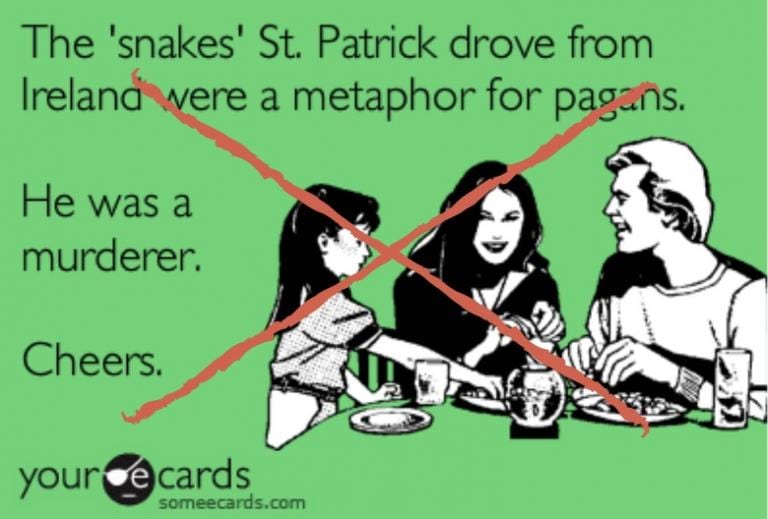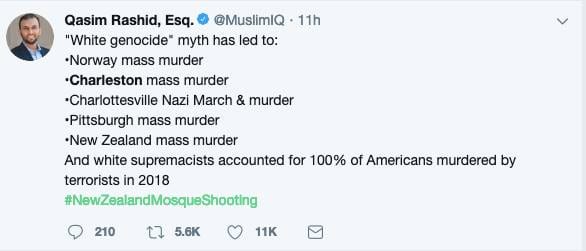It’s that time of year again!
St. Patrick’s Day always brings out the “St. Patrick was a Pagan Killer” memes. I’m sure you’ve heard the story: St. Patrick sparked a “mass conversion” in Ireland, killing all the Pagans if they didn’t convert, then forcing all the Pagans in Europe to become Christians, later sparking the Inquisition, starting CENTURIES of oppression against Pagans, and they were driven underground for a long long long time.

It’s not accurate. And that is a serious problem.
The Church has done a lot of nasty things over the years. I’m not defending it. Exploring its crimes would take another whole blog post, particularly exploring the Church’s role in colonialism, LGBTQ oppression across the globe, the Magdalene laundries, and more. Those are actual things we can prove the Church has done to people across the world. We should be angry about these things.
But many Neo-Pagans believe in a myth of a forced system of conversion across Europe–a myth that has consistently been debunked, yet consistently resurfaces this time of year.

Jason Pitzl wrote an excellent article dispelling the myths, which saves me the time of detailing it all. In short, Christianity was already a force in Ireland long before St. Patrick arrived. Neither St. Patrick or early Irish Christianity were a violent force on Paganism. St. Patrick did not spark a “mass conversion.” He was not responsible for the reduction of Paganism in Europe.
For the most part, Christianity grew slowly across Europe and was composed of the old Pagan rites with new names attached. Norman invasions and codification by the Church in later centuries further removed Pagan practices: a good 1,500 years of gradual change–not a mass, sudden “convert or die” effort. If violent, forced conversions of Pagans did take place in Europe, they were tragic exceptions.
Personally, I don’t believe that the snake was originally meant to represent Irish Paganism. Ireland hasn’t had snakes since the last Ice Age. To me, it sounds more like Irish humor: “What was St. Patrick known for? For driving out the snakes!” perhaps a way of saying, “Who knows what he was known for?”
The moral of the story: There was no Pagan genocide in Europe.

The St. Patrick-Pagan-Killer-Myth often goes hand-in-hand with the Burning Times myth.
The “Burning Times” weren’t an attack on the Paganism we now know, either. Accusations of Witchcraft were less about old Gods and Pagan faith and more about fear of foreigners, mental illness, or disease. In many cases, it was outright anti-Semitism as many of the people burned as Witches were Jewish. Jewish Europeans, not Pagans, experienced the convert-or-die choice. Many did not even have that.
It was a horrible time. It shouldn’t have happened. It should never happen again.
But it was not a Pagan genocide, either.
St. Patrick’s Day also brings up the White Slavery Myth.

Another dangerous myth that surfaces this time of year is that of the “Irish Slavery in the USA” myth: that Irish were enslaved alongside African people, and that in some cases they received worse treatment.
Again, another myth.
The Irish were not enslaved in the United States. Indentured servitude, which brought many Irish to the Americas, was a crappy system, but still a voluntary and a temporary one. Irish Americans experienced discrimination, but were always seen as full persons in the eyes of the law. Enslavement of Africans was neither by choice, nor was it temporary, and African persons were not seen as fully human within the laws of the land. A very, very important distinction.
The myth of white slavery is a particularly dangerous one, long a tool of white supremacy groups looking to discredit social justice movements.
Why does it matter?

Yesterday, 49 people died at the hands of a white supremacist who believed in a white genocide myth, and who decided to kill these people because he believed in that myth. These myths are growing faster and becoming more dangerous and deadly.
Pagans have asked me, “What does Christian persecution of Pagans have to do with the New Zealand shooting?” A lot, actually because they come from a similar source. A myth is dangerous when it points a finger, abdicates responsibility, creates a false narrative, a fake victimhood. It leaves room for someone to feel they should retaliate. The mythical rhetoric of “This is our ancestral legacy and it was taken away by THAT GROUP and must be reclaimed at all costs” is all too similar to the rhetoric that the shooter in New Zealand spouted as he live-streamed the murders. He too believed in a mythical genocide (“a white genocide”).
Ask the questions. Do the research. Read what the scholars have to say before the meme is shared.
Addressing this work begins at home. Remember that the NZ shooter referenced Valhalla. This hits very close to our modern Pagan home.
















